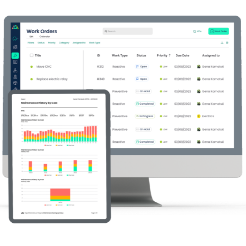
Beyond Names: Designing CMMS Asset Metadata for Better Insights
Computerized Maintenance Management Systems (CMMS) have proven to be essential tools for managing assets, streamlining work orders, and enhancing overall operational efficiency. As they have become more widely used by organizations across various industry sectors, much of the focus has been on asset naming conventions within CMMS platforms. Still, there’s a broader and often overlooked element that plays a critical role in maximizing the system’s value: asset metadata. Simply put, metadata’s importance extends beyond just ascribing labels to encompass the structured details that define an asset's identity, function, and lifecycle; it serves as the backbone for effective maintenance planning and decision-making.
This article examines why organizations should be thinking “beyond names” when implementing their CMMS. By designing asset metadata with greater clarity, consistency, and long-term insight in mind, maintenance teams can gain access to smarter reporting, faster troubleshooting, and seamless cross-functional communication. We’ll explore what makes asset metadata useful, how to structure it for scalability, and why it’s central to integrating CMMS with broader digital transformation efforts.
The Role of Metadata in CMMS
Metadata in a CMMS refers to the structured information that describes and defines assets beyond their names and descriptions. While naming conventions help categorize and identify holdings at a glance, metadata provides additional information, such as context and depth, needed to fully understand an asset’s role, status, and history within the organization. This includes details such as asset type, location, model number, manufacturer, criticality level, installation date, and warranty information. The more comprehensive the metadata is, the more it enables CMMS functionality, from generating accurate maintenance reports and triggering alerts to enabling predictive maintenance through historical data analysis.
Unlike names, which can be shorthand or subjective in how they are entered into the CMMS database, metadata is objective and structured, allowing for consistency across systems and teams. Its real benefit lies in how it enables searchability, segmentation, automation, and integration. For instance, without standardized metadata, it's challenging to use the asset criticality filter during a downtime event or identify components that are reaching the end of their warranty period. In short, metadata transforms a CMMS from a digital filing cabinet into an intelligent maintenance depository capable of driving insights, efficiency, and proactive decision-making.
Beyond the Label: What Makes Metadata Useful
Useful asset metadata extends far beyond its assigned name, providing a comprehensive and searchable profile for each asset. With this additional information, maintenance teams can make informed and timely decisions. Critical fields, such as asset type, location, serial number, manufacturer, and date of installation, provide technicians with a comprehensive understanding of the asset and its place within the broader operational landscape. Additional fields, such as service history, warranty status, expected lifecycle, and associated safety documentation, further enhance this profile, providing teams with immediate access to the necessary context when responding to a failure or conducting routine maintenance.

The value of having structured metadata is especially relevant in day-to-day operations. When a technician receives a work order, they don’t have to spend time digging through old documents or guessing which version of a machine they’re working on. With detailed metadata readily available in the CMMS, they can quickly verify part numbers, check past issues, and understand the asset’s criticality in the production process. This improves efficiency and also reduces the risk of errors and downtime. Furthermore, well-maintained metadata helps with onboarding new team members by reducing dependency on tribal knowledge and ensuring that everyone interacts with the CMMS in a consistent and informed manner.
Structuring Metadata for Scalability
As organizations grow and expand with more assets across multiple sites, the ability to scale metadata consistently becomes essential. Without a structured approach, metadata quickly becomes fragmented, as different departments may use varying formats, terms, or units of measurement, making it difficult to generate reliable reports or benchmark performance. By standardizing metadata fields and formats, such as using dropdown menus for asset types, consistent date formats, or predefined criticality levels, organizations can maintain data integrity while reducing entry errors. This approach ensures that, regardless of who is entering the information or where they are located, the metadata remains cohesive and usable across the entire organization.
Creating a scalable metadata framework also means planning for the future. Looking beyond the present involves anticipating what will be needed as equipment ages, regulations evolve, or systems become more integrated. Thoughtful design of metadata classifications, including asset hierarchies, parent-child relationships, and consistent terminology, enables organizations to expand their CMMS as needed, without requiring a complete overhaul. The benefits of this approach help companies avoid costly rework and ensure that the system remains a valuable tool as operational complexity increases. Scalability in metadata design is what allows a CMMS to grow from a basic tracking system into a central hub for strategic asset management.
Metadata for Smarter Decision-Making
Effectively structured asset metadata opens the door to data-driven decision-making. Instead of relying on anecdotal evidence or manual record reviews, maintenance leaders can use metadata-rich CMMS reports to identify trends, prioritize maintenance activities, and justify capital expenditures. With consistent fields such as failure codes, maintenance frequency, and parts usage linked to each asset, organizations can easily track relevant metrics like mean time between failures (MTBF) or maintenance costs by asset category. These critical insights allow for more intelligent resource allocation, targeted preventive maintenance, and proactive asset replacement planning—all of which contribute to minimizing downtime and extending asset lifespans.
Metadata and CMMS Integrations
Metadata becomes even more valuable when it facilitates smooth communication and information sharing between a CMMS and other digital systems. As organizations increasingly adopt interconnected technologies—such as ERP systems, IoT sensors, and building automation platforms—clean, consistent metadata is the vehicle for seamless data exchange. For example, if an ERP system tracks inventory levels and financial data, and the CMMS tracks asset performance and maintenance history, aligning metadata fields such as asset IDs, location codes, or equipment categories ensures that both systems “speak the same language.” Having this capability enables organizations to gain a unified view of asset performance, costs, and operational status, supporting more informed and holistic decision-making.

Furthermore, a standardized metadata structure is foundational to implementing a Unified Namespace (UNS) architecture. An UNS serves the purpose of aggregating data from various sources into a single source of information. In an UNS, CMMS data bolstered by high-quality metadata contributes real-time asset information to the broader operational ecosystem. For instance, vibration data from a sensor may trigger a maintenance alert in the CMMS, which is then escalated through the ERP for part ordering—all driven by shared metadata. This level of integration enables predictive maintenance, automated workflows, and faster cross-departmental collaboration. Simply put, metadata is not just about organizing information within the CMMS—it’s about making use of the full potential of digital transformation across the organization.
Avoiding Common Metadata Pitfalls
Despite its importance, asset metadata can easily become a source of frustration if it isn’t managed appropriately. One common pitfall is overloading the system with too many custom fields, which can overwhelm users and lead to inconsistent data entry. On the other hand, failing to define clear metadata standards across teams or facilities results in duplicate entries, conflicting terminology, or incomplete records, thereby undermining the very insights the CMMS is intended to provide. Another frequently identified issue is neglecting regular metadata audits. Without regular audits, organizations run the risk of allowing outdated or irrelevant information to remain in their systems, which can potentially compromise their data integrity. To avoid these pitfalls, organizations should strive for balance by creating a metadata structure that captures essential information without overwhelming users, and ensuring that the system is regularly reviewed, cleaned, and refined to maintain its accuracy.
Governance and Ongoing Maintenance of Metadata
Maintaining high-quality metadata is not a one-time task—it requires continued oversight and clearly defined ownership. Successful organizations assign responsibility for metadata management to specific roles, such as maintenance supervisors, CMMS administrators, or data specialists, to ensure accountability for accuracy and consistency. These roles are responsible for enforcing data entry standards, overseeing metadata-related training, and coordinating periodic reviews to ensure consistency and accuracy across all data entry processes. Clear documentation of metadata guidelines—such as which fields are mandatory, how to use dropdown selections, and when to update asset information—helps avoid confusion and reduces the risk of incomplete or inconsistent data being introduced into the system.
In addition to assigning roles, organizations should implement a routine process for auditing and updating metadata. As assets age, are replaced, or undergo changes in operational roles, their associated metadata must be updated to reflect these changes. Without regular oversight, there is an increased risk that the CMMS will become cluttered with outdated or irrelevant information. When this happens, its value as a strategic maintenance tool is weakened. By treating metadata as an evolving component of the maintenance strategy—and not a static checklist—organizations can ensure their CMMS remains a reliable and insightful resource, as it is designed to be.
Conclusion
Designing and maintaining asset metadata within a CMMS is much more than a technical exercise—it’s a strategic decision that directly impacts maintenance efficiency, reporting accuracy, and long-term asset performance. When metadata is purposefully structured and actively managed, it empowers teams to go beyond reactive fixes and start leveraging data for preventive planning, cost optimization, and smarter resource allocation. With the proper use of metadata, forward-thinking organizations recognize it as the foundation for actionable insights and meaningful digital transformation.
TABLE OF CONTENTS
Keep Reading
The longest U.S. federal government shutdown to date lasted 43 days, beginning on October 1, ...
5 Dec 2025
Every maintenance professional faces it sooner or later — that critical time when an aging ...
18 Nov 2025
The term 'best' is often used loosely, without a clear understanding of its context or ...
14 Nov 2025
In the not too distant past, maintenance strategies have been defined by reaction—fixing ...
13 Nov 2025
Tax season is the time of year that often sends a ripple of anxiety through many of us. The ...
11 Nov 2025
Selecting a Computerized Maintenance Management System (CMMS) can, at first glance, be an ...
4 Nov 2025
In healthcare facilities, equipment uptime involves more than achieving operational ...
31 Oct 2025
Companies are subject to economic ups and downs, also known as economic volatility. Today, ...
30 Oct 2025
Maintenance challenges are a constant struggle, with unplanned downtime costing manufacturers ...
27 Oct 2025
Last winter, a maintenance technician at a U.S. paper mill ignored a predictive alert that ...
10 Oct 2025
Many organizations proudly say they “have a CMMS,” but ownership alone doesn’t equal ...
9 Oct 2025
Every maintenance team is under pressure to do more with less. Unplanned downtime is often ...
7 Oct 2025
The implementation of simple, yet powerfully effective, checklists has repeatedly ...
3 Oct 2025
In manufacturing, every second counts. When production stops, whether due to scheduled ...
2 Oct 2025
The increasing cost of maintenance, lack of accountability, and siloed systems leave many ...
30 Sep 2025
Preventive maintenance is one of those things maintenance teams know they need to do, but it ...
26 Sep 2025
Public services are essential to daily life. The provision of safe roads, functional transit, ...
25 Sep 2025
For most manufacturing facilities, a major focus of their maintenance teams revolves around ...
24 Sep 2025
Have you ever tried explaining to the CEO why the production line has been down for hours ...
18 Sep 2025
Over the past few decades, the hotel industry has undergone a dramatic transformation. ...
16 Sep 2025





